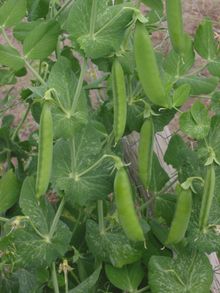 | |
| Pea plant in full fruit. |
Peas originated in the Mediterranean and Middle East regions, they are eaten fresh or cooked. They can be frozen, canned (pressure can method), or dried. Peas are harvestable between 50 and 75 days depending on variety. There are three primary types of pea; the snow pea, snap pea, and shelling pea. Shelling peas are removed from the pod and only the pea seeds are eaten as the pods are tough and tasteless. Snow peas are the variety most often seen in stir fries, whole pods with smaller undeveloped seeds inside. Snap peas are eaten in the pod as well, but are even sweeter than snow peas and have a crisp, thick pod that is nearly stringless. Depending on which way you prefer to eat your peas you could plant one, two or all three types of pea in your garden.
Peas are one of the first things planted in the spring, they can germinate in soils that are only 40 degrees F. So long as the risk of hard frost has passed they can go directly into the garden. Peas should be sown in the ground, rather than started indoors. They are long and slim vining plants and don't always cope well with transplanting, they are also such fast growers, and have such large seeds that it's just much simpler to put them in the garden. If they fail to germinate in a week or so, plant another round and keep waiting. Pea seeds should be planted fairly deep, about an inch underground. They take up little room and require little nutrition, they can be planted as close as 1-2 inches apart. Or in SFG style, 8 plants to a square. Pea seeds will only be viable for about 2 years, so despite their inexpensive price don't be tempted to stock up too much. Peas are very easy to save seed from, simply leave the end-of-season crop on the vine until they brown and become dry, then harvest, dry further inside, then shell and store seeds in paper bags. (Avoid plastic bags as they can trap any remaining moisture and rot your seeds). Peas also self-pollinate, they don't require pollinators, and generally each flower will pollinate itself. This means that to accidentally cross two pea plants you pretty much have to rub them together. Pea seed will fairly reliably produce seed that grows the same plants as the previous generation.
A cool season crop, peas prefer temperatures below 70 degrees. Peas that mature in temperatures over 85 degrees can develop tough pods. Also, peas stop putting on flowers once temperatures get over about 85 degrees. Harvest continually to ensure continued production of fruits. You can increase your harvest by using a pea innoculant, but innoculant in no way guarantees a great harvest.
The greatest risk to peas is the enation virus, and you should watch for enation resistant varieties when selecting peas for your garden. Peas actually build nitrogen stores in the soil they are planted in, so are a great winter crop or rotation crop to keep in the organic garden. Move them around each year, or start an early spring crop in the space of later heavy feeders. By the time the peas are finishing their growth the heavy feeding summer plants should be ready to put outside.
As vining crops peas will need a trellis of some type, which also helps to keep the fruits up off the ground and in easy picking reach. Peas are an inexpensive, simple to germinate, delicious crop to grow and are perfect for gardens that have small children around. Kids can pick them easily, eat them straight from the vine, watch how they grow and twine around each other and the trellis. In general peas are a great crop for anyone.
 |
| Snow peas, purple beans, and zucchini: one day's harvest. |
Next time: Pea Recipes, My Own and links to others.

No comments:
Post a Comment